哈工大力学习题课下
- 格式:ppt
- 大小:1.37 MB
- 文档页数:34

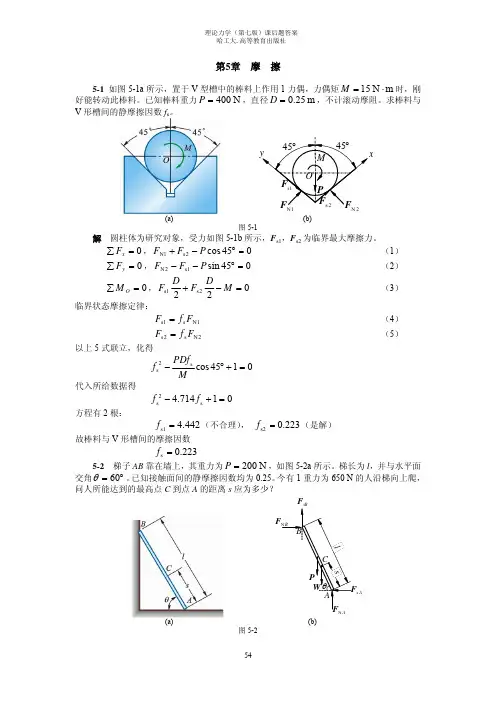
第5章 摩 擦5-1 如图5-1a 所示,置于V 型槽中的棒料上作用1力偶,力偶矩m N 15⋅=M 时,刚好能转动此棒料。
已知棒料重力N 400=P ,直径m 25.0=D ,不计滚动摩阻。
求棒料与V 形槽间的静摩擦因数f s 。
(a)(b)图5-1解 圆柱体为研究对象,受力如图5-1b 所示,F s1,F s2为临界最大摩擦力。
0=∑x F ,045cos 2s 1N =°−+P F F (1) 0=∑y F ,045sin 1s 2N =°−−P F F (2) 0=∑O M ,0222s 1s =−+M DF D F(3)临界状态摩擦定律:1N s 1s F f F =(4) 2N s 2s F f F =(5)以上5式联立,化得 0145cos s2s =+°−MPDf f 代入所给数据得01714.4s 2s =+−f f 方程有2根:442.4s1=f (不合理), 223.0s2=f (是解)故棒料与V 形槽间的摩擦因数223.0s =f5-2 梯子AB 靠在墙上,其重力为N 200=P,如图5-2a 所示。
梯长为l ,并与水平面交角°=60θ。
已知接触面间的静摩擦因数均为0.25。
今有1重力为650 N 的人沿梯向上爬,问人所能达到的最高点C 到点A 的距离s 应为多少?AN F As F(a)(b)图5-2解 梯子为研究对象,受力如图5-2b 所示,刚刚要滑动时,A ,B 处都达最大静摩擦力。
人重力N 650=W ,平衡方程: 0=∑x F , 0s N =−A B F F (1) 0=∑y F , 0s N =−−+W P F F B A(2)0=∑A M ,060cos 60sin 60cos 60cos 2s N =°−°−°+°l F l F Ws lPB B (3) 临界补充方程:A s A F f F N s = (4)B s B F f F N s =(5)联立以上5式,解得 N 80012sN =++=f WP F A ,N 200s =A F N 200)(12s N =++=W P f f F sB ,N 50s =B F l PF f W l s B 456.02)3[(N s =−+=5-3 2根相同的匀质杆AB 和BC ,在端点B 用光滑铰链连接,A ,C 端放在不光滑的水平面上,如图5-3a 所示。
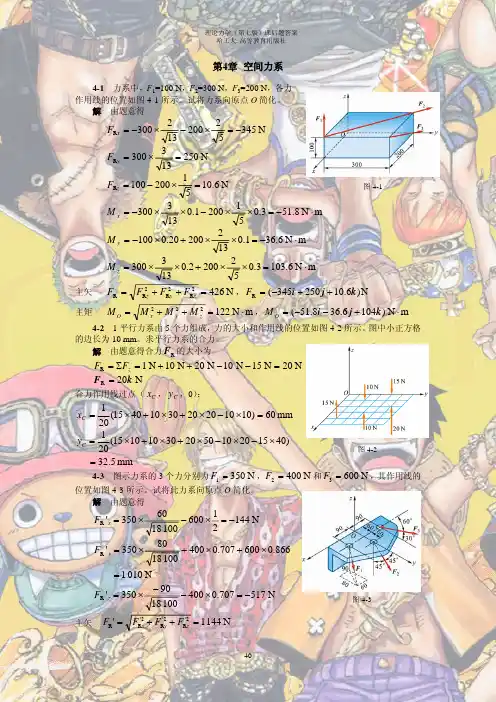
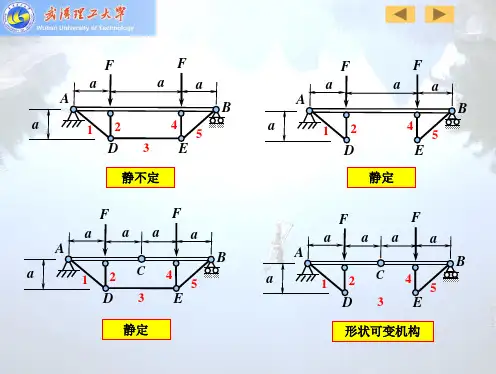
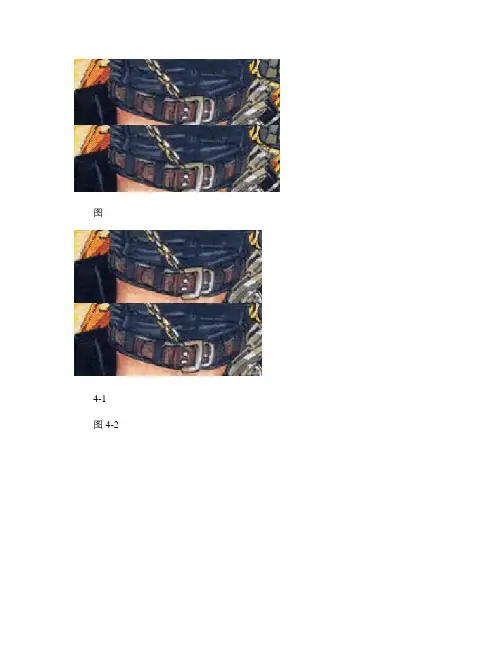


(1)For a plane stress state, if the y-coordinate is regarded as a symmetric axis, try to make a sketch and write down the displacement boundary conditions at the symmetric axis in finite element modeling. (6 points) Solution:As shown in the figure, for a symmetric problem, we may define 0==A A v u at point A ; and at point B , 0=B u(2)Try to use the Castigliano’s first theorem to obtain the matrix equilibrium equations for the system of springs shown in the following Figure.(10 points)Solution :For the spring element, the strain energy is given by ()221u k U e ∆=In which, k – stiffness of the spring, u ∆ - deflection of the spring.The total strain energy of the system of four springs is expressed by means of the nodal displacements and spring constants as2454234322322121)(21)(21)(21)(21U U k U U k U U k U U k U e -+-+-+-=By application of the Castigliano’s first theorem for each element12111211)()1)((F U U k U U k U U e=-=--=∂∂23221212)()(F U U k U U k U U e=-+-=∂∂ 34332323)()(F U U k U U k U U e=-+-=∂∂ 45443434)()(F U U k U U k U U e=-+-=∂∂ 54545)(F U U k U U e=-=∂∂ The system stiffness matrix can be written as⎪⎪⎪⎭⎪⎪⎪⎬⎫⎪⎪⎪⎩⎪⎪⎪⎨⎧=⎪⎪⎪⎭⎪⎪⎪⎬⎫⎪⎪⎪⎩⎪⎪⎪⎨⎧⎥⎥⎥⎥⎥⎥⎦⎤⎢⎢⎢⎢⎢⎢⎣⎡--+--+--+--54321432444433332222111100000000000000F F F F F U U U k k k k k k k k k k k k k k k k(3)The interpolation functions for a beam element of length L arewrite down a polynomial representation of the displacement field )(x v in terms of the above interpolation functions and show that 22/dx v d = constant for the beam element subject to pure bending. (12 points) Solution :The displacement field for a beam element is332220)(x a x a x a a x v +++=It can also be expressed in terms of interpolation functions and nodal variables as24231211)(θθN v N N v N x v +++=Substitute the interpolation functions into the above equation and after a few manipulations, we have24231211θθdxdN v dx dN dx dN v dx dN dx dv +++=22223221221322326634166θθ⎪⎪⎭⎫ ⎝⎛+-+⎪⎪⎭⎫ ⎝⎛-+⎪⎪⎭⎫ ⎝⎛+-+⎪⎪⎭⎫ ⎝⎛+-=L x L x v L x L x L x L x v L x L x 2223212132226212664126θθ⎪⎭⎫ ⎝⎛+-+⎪⎭⎫ ⎝⎛-+⎪⎭⎫ ⎝⎛+-+⎪⎭⎫ ⎝⎛+-=L x L v L x L L x L v L x L dx v d for the beam element subject to pure bending, we have21v v =, 21θθ-=So, constant 22411122=-=+-=θθθLL L dx v d (4)For a 2D problem, if the mid-points of each side of a triangular element are alsodefined as nodal points, try to write down an appropriate polynomial representationof the displacement field variable, and discuss its convergence conditions. (14 points )Solution :The polynomial representation of the displacement field variable can be written as26524321y a xy a x a y a x a a u +++++=21211210987y a xy a x a y a x a a v +++++=The convergence conditions include: (1) the compatibility conditions.Since the above equations are continuous within the element, so the displacement field iscontinuous in the element.On the common boundary, the side line is a quadratic function that has three independent constants. And since there are three nodes, the boundary curve can be uniquely determined by the quadratic function, so on the common boundary, there is no void, no material overlap either.(2) the completeness condition.The rigid body motion can be determined by the constants 1a and 7a The rigid body rotation can be realized by3a y u =∂∂, and 8a xv =∂∂ The constant strain condition can be satisfied by2a xux =∂∂=ε, 9a y v y =∂∂=ε, and 83a a x v y u xy +=∂∂+∂∂=γIn summary, convergence conditions are satisfied for the element.(5)Considering a beam element, Denoting the element length by L and the moment ofinertia of the cross-sectional area by z I , write down an appropriate function to express the displacement field, and finally, derive the finite element equation and nodal forces of the element by using the Galerkin ’s method. (18 points)Solution :The governing equation for the problem of beam flexure is)(d d d d 2222x q x v EI x z =⎪⎪⎭⎫ ⎝⎛ The displacement solution can be written as∑==+++=4124231211)()()()()()(i i i x N x N v x N x N v x N x v δθθTherefore, the element residual equations are4,10d )(d d d d )(212222==⎥⎦⎤⎢⎣⎡-⎪⎪⎭⎫⎝⎛⎰i x x q x v EI x x N x x z iIntegrating the derivative term by parts and assuming a constant z EI , we obtain4,10d )(d d d d d d d )(2121213333==--⎰⎰i x x q N x x vx N EI xvEI x N xx i x x i z x x z iand since3322d d d d d d d d x vEI x v EI x x M V z z -=⎪⎪⎭⎫ ⎝⎛-=-= Integrating again by parts and rearranging gives4,1d d d d d d d )(d d d d d 2121212122332222=+-=⎰⎰i xvEI x N x v EI N x x q N x x v x N EI x x z i x x z i xx i x x i zThe shear forces and bending moments at element nodes now explicitly appear in the element equations.The above equation can be written in the matrix form }{}]{[F k =δ where the terms of thestiffness matrix are defined by4,1,d d d d d 222221==⎰j i x x N xN EI k jx x i z ijThe terms of the element force vector are defined by4,1d d d d d d d )(2121212233=+-=⎰i xvEI x N x vEI N x x q N F x x z i x x x x z i i ior,4,1)(d d )(d )(212121=++=⎰i x M xN x V N x x q N F xx i x x xx i i iwhere the integral term represents the equivalent nodal forces and moments produced by the distributed load.(6)Consider the three-node line element with interpolation functionsUse the element as the parent element in the isoparametric mapping332211)()()(x r N x r N x r N x ++=with 321x x x << but otherwise arbitrary nodal coordinates. a.b. How does the x coordinate vary between nodes of the isoparametric element?c. Has the basic element geometry changed from that of the parent element?d.e.Determine the Jacobian matrix for the transformation ,and calculate the Jacobianmatrix for the basic element with nodal coordinates 03and ,0,0.2321.x x x ==-=.f. Find the inverse of the Jacobian matrix, and calculate its value for the above basic element too.g. Calculate the value of determinate J at a point with 25.0=r .(20 points)Solution :a. 332211)()()(x r N x r N x r N x ++=32212)2()44()132(x r r x r r x r r -+-++-=It can be seen that the x coordinate vary as a quadratic function between nodes of the isoparametric elementb. the basic element geometry may change from that of the parent element. The basic element is still a straight line element, however, its length may change. The length of the parent element is 1, and the length of the basic element is 13x x -.c. the Jocabian matrix can be written as[]⎥⎦⎤⎢⎣⎡∂∂=⎥⎦⎤⎢⎣⎡∂∂=∑=31i i i x r N r x JThat is 321)14()21(4)34(][x r x r x r J -+-+-=for the basic element with nodal coordinates 03and ,0,0.2321.x x x ==-=we have 3431268][+=-++-=r r r Jd. the inverse of the Jocabian matrix is 3211)14()21(4)34(1][x r x r x r J -+-+-=-for the basic element with nodal coordinates 03and ,0,0.2321.x x x ==-=we have 341][1+=-r Je. T he value of determinate J at a point with 25.0=r is calculated by434=+=r J。
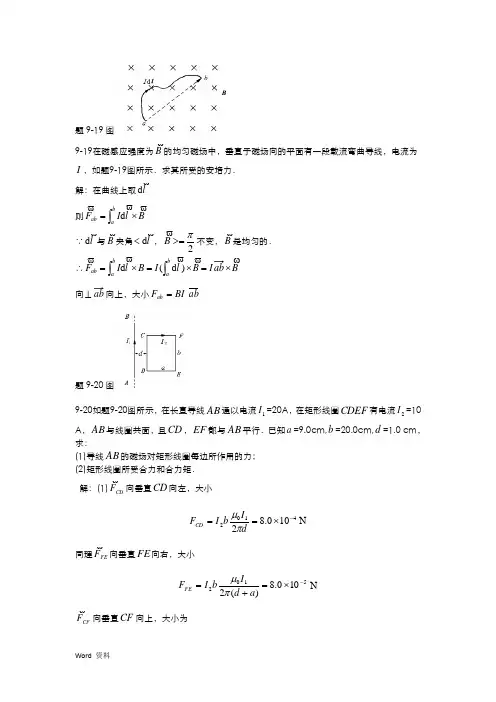
题9-19图9-19在磁感应强度为B的均匀磁场中,垂直于磁场向的平面有一段载流弯曲导线,电流为I ,如题9-19图所示.求其所受的安培力.解:在曲线上取ld则 baab B l I F d∵l d 与B 夹角l d ,2B 不变,B是均匀的.∴ b ab aab B ab I B l I B l I F)d (d向⊥ab 向上,大小BI F ab ab题9-20图9-20如题9-20图所示,在长直导线AB 通以电流1I =20A ,在矩形线圈CDEF 有电流2I =10 A ,AB 与线圈共面,且CD ,EF 都与AB 平行.已知a =9.0cm,b =20.0cm,d =1.0 cm ,求:(1)导线AB 的磁场对矩形线圈每边所作用的力; (2)矩形线圈所受合力和合力矩.解:(1)CD F向垂直CD 向左,大小4102100.82 dI bI F CD N 同理FE F向垂直FE 向右,大小5102100.8)(2 a d I bI F FE NCF F向垂直CF 向上,大小为ad dCF dad I I r r I I F 5210210102.9ln 2d 2N ED F向垂直ED 向下,大小为5102.9 CF ED F F N(2)合力ED CF FE CD F F F F F向向左,大小为4102.7 F N合力矩B P M m∵线圈与导线共面∴ B P m//0 M.10-1 一半径r =10cm 的圆形回路放在B =0.8T 的均匀磁场中.回路平面与B垂直.当回路半径以恒定速率trd d =80cm ·s -1 收缩时,求回路中感应电动势的大小. 解: 回路磁通2πr B BS m 感应电动势大小40.0d d π2)π(d d d d 2trr B r B t t m V 10-4 如题10-4图所示,载有电流I 的长直导线附近,放一导体半圆环MeN 与长直导线共面,且端点MN 的连线与长直导线垂直.半圆环的半径为b ,环心O 与导线相距a .设半圆环以速度v 平行导线平移.求半圆环感应电动势的大小和向及MN 两端的电压N M U U .解:作辅助线MN ,则在MeNM 回路中,沿v向运动时0d m ∴ 0 MeNM 即 MN MeN 又∵ba ba MN ba ba Iv l vB 0ln 2d cos 0 所以MeN 沿NeM 向, 大小为ba ba Iv ln20 M 点电势高于N 点电势,即ba ba Iv U U N Mln20 10-6如题10-6图所示,用一根硬导线弯成半径为r 的一个半圆.令这半圆形导线在磁场中以频率f 绕图中半圆的直径旋转.整个电路的电阻为R .求:感应电流的最大值.题10-6图解: )cos(2π02t r B S B m ∴Bfr f r B r B t r B t m m i 222202ππ22π2π)sin(2πd d ∴RBf r R I m22π 10-7 如题10-7图所示,长直导线通以电流I =5A ,在其右放一长形线圈,两者共面.线圈长b =0.06m ,宽a =0.04m ,线圈以速度v =0.03m ·s -1垂直于直线平移远离.求:d =0.05m 时线圈中感应电动势的大小和向.题10-7图解: AB 、CD 运动速度v向与磁力线平行,不产生感应电动势. DA 产生电动势ADIvbvBb l B v d2d )(01BC 产生电动势)(π2d )(02d a Ivbl B v CB∴回路中总感应电动势8021106.1)11(π2ad d Ibv V 向沿顺时针.10-14 如题10-14图所示,在垂直于直螺线管管轴的平面上放置导体ab 于直径位置,另一导体cd 在一弦上,导体均与螺线管绝缘.当螺线管接通电源的一瞬间管磁场如题10-14图示向.试求:(1)ab 两端的电势差;(2)cd 两点电势高低的情况.解:由 l S t B l Ed d d d 旋知,此时旋E 以O 为中心沿逆时针向. (1)∵ab 是直径,在ab 上处处旋E与ab 垂直∴ll 0d 旋∴0 ab ,有b a U U (2)同理,0dl E cddc旋∴ 0 c d U U 即d c U U题10-15图10-15 一无限长的直导线和一正形的线圈如题10-15图所示放置(导线与线圈接触处绝缘).求:线圈与导线间的互感系数.解:设长直电流为I ,其磁场通过正形线圈的互感磁通为32300122ln π2d π2a a Iar rIa∴2ln π2012aIM10-16 一矩形线圈长为a =20cm ,宽为b =10cm ,由100匝表面绝缘的导线绕成,放在一无限长导线的旁边且与线圈共面.求:题10-16图中(a)和(b)两种情况下,线圈与长直导线间的互感.解:(a)见题10-16图(a),设长直电流为I ,它产生的磁场通过矩形线圈的磁通为2ln π2d 2πd 020)(12Iar r Ia S B b b S∴6012108.22ln π2a N I N M H (b)∵长直电流磁场通过矩形线圈的磁通012 ,见题10-16图(b) ∴0 M题10-16图题10-17图10-17 两根平行长直导线,横截面的半径都是a ,中心相距为d ,两导线属于同一回路.设两导线部的磁通可忽略不计,证明:这样一对导线长度为l 的一段自感为lL 0Inaad . 解:如图10-17图所示,取r l S d d 则ad aad aad da a d Il r r r Ilr l r Ir πI)ln (ln 2πd )d 11(π2d ))d (π22(0000 aad Illnπ0∴a a d l I L lnπ0 10-18 两线圈顺串联后总自感为1.0H ,在它们的形状和位置都不变的情况下,反串联后总自感为0.4H .试求:它们之间的互感. 解:∵顺串时M L L L 221 反串联时M L L L 221 ∴M L L 415.04L L M H 11-5 半径为R =0.10m 的两块圆板构成平行板电容器,放在真空中.今对电容器匀速充电,使两极板间电场的变化率为tEd d =1.0×1013 V ·m -1·s -1.求两极板间的位移电流,并计算电容器离两圆板中心联线r (r <R )处的磁感应强度Br 以及r =R 处的磁感应强度BR .解:(1) tEt D j D 08.22 R j S j I D D D A(2)∵S j I l H SD ld d 0取平行于极板,以两板中心联线为圆心的圆r l 2 ,则22d d 2r tE r j r H D ∴tEr H d d 20tEr H B r d d 2000当R r 时,600106.5d d 2tER B R T12-1 某单色光从空气射入水中,其频率、波速、波长是否变化?怎样变化?解:不变,为波源的振动频率;nn 空变小; n u 变小.12-2 在氏双缝实验中,作如下调节时,屏幕上的干涉条纹将如变化?试说明理由. (1)使两缝之间的距离变小;(2)保持双缝间距不变,使双缝与屏幕间的距离变小; (3)整个装置的结构不变,全部浸入水中; (4)光源作平行于1S ,2S 联线向上下微小移动; (5)用一块透明的薄云母片盖住下面的一条缝. 解:由 dDx知,(1)条纹变疏;(2)条纹变密;(3)条纹变密;(4)零级明纹在屏幕上作相反向的上下移动;(5)零级明纹向下移动. 12-3 什么是光程? 在不同的均匀媒质中,若单色光通过的光程相等时,其几路程是否相同?其所需时间是否相同?在光程差与位相差的关系式2 6中,光波的波长要用真空中波长,为什么?解:nr .不同媒质若光程相等,则其几路程定不相同;其所需时间相同,为Ct. 因为 中已经将光在介质中的路程折算为光在真空中所走的路程。

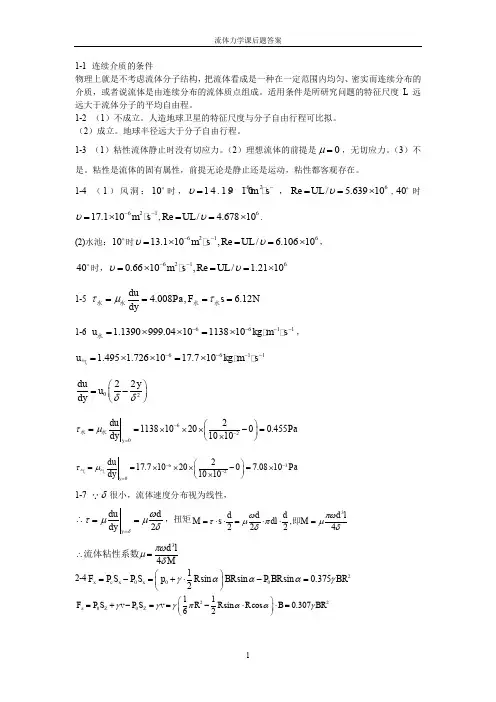
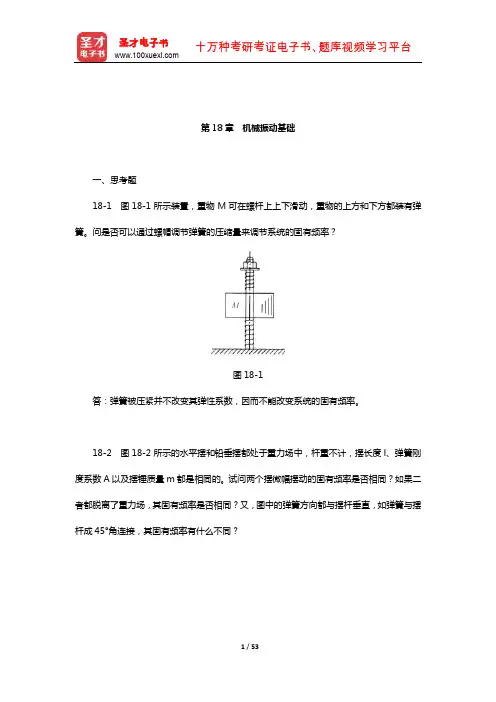
理论力学(I)第六版哈尔滨工业大学理论力学教研室第二章 平面汇交力系与平面力偶系2-1铆接薄板在孔心A 、B 和C 处受三力作用,如题2-1图(a )所示。
F 1=100N ,沿铅直方向;F 3=50N ,沿水平方向,并通过点A ;F 2=50N ,力的作用线也通过点A ,尺寸如题2-1图(a)所示。
求此力系的合力。
解法一 几何法。
应用力的多边形法,将力F 1、F 2和F 3首尾相接后,再从F 1的起点至F 3的终点连一直线,此封闭边便是三力的合力F R ,如题2-1图(b )所示。
根据预先选好的比例尺,利用直尺和量角器便可确定合力F R 的大小和方向。
解法二 解析法。
合力的矢量表达式为∑∑+=+=j F i F j F i F F y x Ry Rx R即合力R F 在x 轴和y 轴上的投影,分别等于力系各力在同一坐标轴上投影的代数和,所以有:N N F F F F xx x Rx 805080606050022321=⎪⎪⎭⎫ ⎝⎛++⨯+=++= N N F F F F yy y Rx 14008060805010022321=⎪⎪⎭⎫ ⎝⎛++⨯+=++= 所以,合力的大小为:N N F F F Ry Rx R2.161140802222=+=+=合力F R 与x 轴的夹角为:︒===24.602.16180arccos cosR Rx F F acr α 2-3物体重P=20kN ,用绳子挂在支架的滑轮B 上,绳子的另一端接在铰车D 上,如题2-3图(a )所示。
转动铰车,物体便能升起。
设滑轮的大小、AB 与CB 杆自重及磨擦略去不计,A 、B 、C 三处均为铰链连接。
当物体处于平衡状态时,试求拉杆AB 和支杆CB 处受的力。
解:这是一个平面汇交力系的平衡问题。
选取滑轮B 为研究对象,并作B 点的受力图,如题2-3图(b )所示。
由平衡方程∑∑==0,0y xF F,有:030sin 30cos =︒-︒+-T F F BC BA (1) 030cos 30sin =-︒-︒P T F BC (2)因忽略了滑轮B 的磨擦,所以P=T ,将P 、T 的数值代入(2)式,得KN F BC 64.74=将T 和F BC 的数值代入(1)式,得:kN F BA64.54=所以拉杆AB 和CB 分别受拉力54.64kN 和压力74.64kN 。